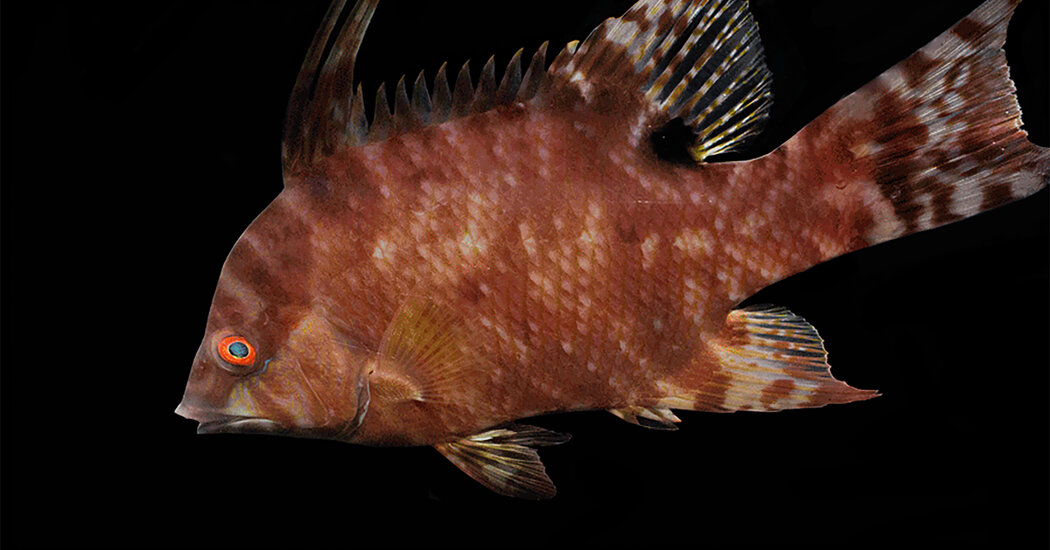

As a marine biologist, Lorian Schweikert knew hogfish could change color to match their surroundings. But as an angler, she noticed something that wasn’t in the textbooks: Hogfish can camouflage even after they’re dead.
When Dr. Schweikert saw a hogfish with a conspicuous spearfishing hole through its body change color to match the texture of a boat’s deck, “it gave me this idea that the skin itself was ‘seeing’ the surrounding environment,” she said.
New research by Dr. Schweikert and her team provides a compelling explanation for how and why hogfish blend into their background, even in the afterlife. In a study published on Tuesday in the journal Nature Communications, they identified a mysterious new type of cell deep in the hogfish’s skin that might allow the fish not only to monitor its surroundings but also to edit its skin color.
Hogfish are masters of change. They’re sequential hermaphrodites, meaning every hogfish hatches female but can become male once it reaches a certain size or if a power vacuum arises in its social group. And as they cruise the reefs and sand flats of the western Atlantic, hogfish can toggle between three color morphs — a ruddy brown, a pearly white and a stripy or dappled red coloration — in less than a second.
Dr. Schweikert suspected that the hogfish’s ability to camouflage while dead was just a quirk, that some part of the color-changing system was taking a while to get the memo that it was a former fish. Earlier in her quest to figure out how hogfish pull off their “zombie” color change without a living brain, Dr. Schweikert used genetic analysis to discover that there were opsins — light-detecting proteins also found in human retinas — in the hogfish’s skin. But what exactly were the opsins doing? And why “see” through the skin at all when hogfish have a perfectly good pair of eyes?
Dr. Schweikert hoped the answer might lie in the arrangement of the cells in the hogfish’s skin. She and her team used glowing antibodies to pinpoint the opsins, and transmission electron microscopy allowed them to peer into the cellular structures.
The imaging revealed that the opsins weren’t on the surface of the skin, where they would have the best view of the outside world. Instead, they were beneath a layer of chromatophores — “inkjet” cells that produce a color change by expanding and contracting packets of pigment — and concentrated in a previously unknown cell type.
“I absolutely screamed,” said Dr. Schweikert, now an assistant professor of biology at the University of North Carolina Wilmington. “Nothing had ever been seen like this.”
Beneath each chromatophore is a cell chock-full of opsins — the first specialized cell for dermal photoreception or “skin sight” identified in a vertebrate, the authors say.
Other researchers who study dermal photoreception say the results are striking. Dr. Schweikert and her team achieved a “crazy amount of detail,” said Desmond Ramirez, a postdoctoral researcher at the University of Massachusetts Amherst who has studied dermal photoreception in octopuses and was a peer reviewer of the paper.
Todd Oakley, an evolutionary biology professor at the University of California, Santa Barbara, who has also studied octopus dermal photoreception and wasn’t involved in the paper, said the new research went a long way toward explaining the relationship between chromatophores and opsins in hogfish.
The structural arrangement the team identified suggests that hogfish cells aren’t just being used to look at the outside world. Dr. Schweikert had been puzzled when a previous study revealed the opsins were attuned to blue light, which might not be very useful in the blue ocean.
But everything clicked when the team realized that the chromatophores might act as a filter, Dr. Schweikert said. Additional experiments confirmed that the red-brown of the hogfish’s chromatophore pigments absorb most blue light — meaning the redder the fish, the less blue light makes it through to the opsins.
This would allow the hogfish to tweak the accuracy of its color matches to better evade predators. How well it’s dressed for the occasion is a matter of life and death, and it “can’t very well bend its neck to look,” said Sönke Johnsen, a biology professor at Duke University and a co-author of the paper.
Despite the newly discovered cells, for hogfish it’s not as simple as having a secret ingredient that makes skin sight possible.
“People often focus on the materials in biology as being magical,” Dr. Johnsen said. “What’s really magical is the structure — biology is able to take some fairly run-of-the-mill molecules and build almost anything by putting them together.”
24World Media does not take any responsibility of the information you see on this page. The content this page contains is from independent third-party content provider. If you have any concerns regarding the content, please free to write us here: contact@24worldmedia.com

This Lava Tube in Saudi Arabia Has Been a Human Refuge for 7,000 Years

Four Wild Ways to Save the Koala (That Just Might Work)

National Academy Asks Court to Strip Sackler Name From Endowment

Ways Industrial Copper Helps Energy Production

The Ins and Out of Industrial Conveyor Belts

She Dreams of Pink Planets and Alien Dinosaurs

Why Your Family Should Play With Your Pet Outdoors

Arkansas Braces for Flood of Tourists During Total Solar Eclipse

New England Journal of Medicine Ignored Nazi Atrocities, Historians Find

Judge Orders Timely Housing for Migrant Children Waiting at Border

Community calendar: April 4, 2024

Real Estate Transfers: April 4, 2024